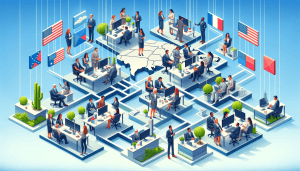Estimated reading time: 7 minutes
Key Takeaways
- Customer experience (CX) spans every touchpoint, from first enquiry to post-purchase support.
- Traditional CX prioritises human connection through face-to-face and phone interactions.
- Modern CX leverages omnichannel journeys, automation, and data to deliver speed and scale.
- Key differences include engagement style, personalisation methods, feedback loops, channels, scalability, and cost.
- The optimal approach blends human empathy with digital efficiency for satisfaction and loyalty.
Table of contents
Introduction
Customer experience (CX) covers every point of contact between a company and its customers, from the first enquiry right through to post-purchase support. The debate over traditional versus modern approaches is growing as firms face rising consumer expectations and rapid technological change. People now demand prompt, seamless service on whichever channel they choose.
Business practice has shifted sharply during the past few decades. What once relied on face-to-face chats and telephone lines now sits within a complex mesh of digital touchpoints, automated workflows, and data-driven tactics. Knowing how the two styles differ is crucial for any company seeking stronger satisfaction rates and deeper loyalty.
To forge meaningful bonds, leaders must weigh the strengths and limits of both styles. The pages that follow outline the contrasts, the gains each side offers, and practical ways to blend them into a superior overall experience.
Defining Traditional Customer Experience
Traditional CX revolves around direct human contact and tailored attention, the dominant model before the digital age and still a mainstay in many sectors.
Core Elements
- Face-to-face service — Shop visits, consultations, and meetings give scope for nuanced discussion and instant replies.
- Telephone support — Speaking with a real representative offers immediate help and the reassurance of a human voice.
- Individualised assistance — One-to-one problem solving makes customers feel valued because their exact situation is understood.
- Relationship building — Ongoing contact with the same staff member nurtures trust over time.
Personal connection matters most in fields such as luxury retail, real estate, financial advice, and healthcare. Clients in these arenas prize the trust and community spirit that stem from genuine human encounters.
Sometimes customers simply prefer a knowledgeable person who can reassure them in ways no digital script can match.
Defining Modern Customer Experience
Modern CX uses digital tools to create smooth interactions across many platforms, letting companies serve far more people with greater speed.
Distinct Features
- Omnichannel engagement — Shoppers expect identical quality whether on a website, mobile app, social feed, or messaging service. Linking these touchpoints produces a single, coherent experience.
- AI chatbots and automation — Intelligent systems handle routine questions around the clock, freeing agents for complex cases.
- Real-time support — Live chat, instant messages, and social replies slash wait times.
- Data-driven insight — Analysing behaviour and feedback allows personalisation at scale without manual effort.
- Proactive service — Predictive analytics flag likely issues so they can be solved before the customer notices.
The modern customer path is non-linear and interactive. People move back and forth between discovery, consideration, purchase, and advocacy across digital and physical points of contact. Firms using modern tools track these complex paths, spot pain points, and refine experiences continuously.
Technology also enables personal touches at scale. For instance, an online shop might suggest items based on browsing habits, while email software sends tailored messages tied to past actions.
Key Differences Between Traditional and Modern CX
Knowing the contrasts helps firms pinpoint gaps and plan updates.
Customer Engagement
- Traditional: Personal, face-to-face exchanges build bonds through direct contact
- Modern: Digital and automated interactions prioritise convenience and speed
Personalisation
- Traditional: Based on staff memory and long-term familiarity
- Modern: Guided by data analysis that adapts offers in real time
Feedback Collection
- Traditional: Comment cards, formal surveys, or verbal remarks
- Modern: Instant ratings, social listening, and automated follow-ups
Communication Channels
- Traditional: Single channel, such as an office visit or phone call
- Modern: Websites, email, social media, apps, SMS, and video calls
Service Style
- Traditional: Mainly reactive, solving issues once raised
- Modern: Largely proactive, spotting and fixing likely problems early
Scalability
- Traditional: Constrained by staff numbers and location
- Modern: Grows easily through automation and cloud platforms
Cost Profile
- Traditional: Labour heavy, with higher fixed expense per contact
- Modern: Lower marginal costs after upfront investment in tech
| Aspect | Traditional CX | Modern CX |
|---|---|---|
| Main interaction | In person, telephone | Digital channels, automation |
| Response time | Business hours | Often instant, 24/7 |
| Data use | Limited, manual | Extensive, automated |
| Customer effort | Higher (travel, waiting) | Lower (anywhere, anytime) |
| Personalisation method | Human memory | Algorithms and analytics |
These contrasts show how modern methods shift CX from a solely relationship-based approach to one that balances technology with personal touches across many points of contact.
Benefits of Traditional Customer Experience
Strengthens Loyalty
Regular contact with the same staff builds trust. Remembered preferences and history create emotional ties that drive repeat business.
Face-to-face conversation also allows representatives to notice tiny cues in tone or body language, helping them solve unvoiced concerns and deliver satisfying results.
Raises Satisfaction
Tailored, real-time adjustments meet individual needs better than scripted replies. Human empathy proves crucial when problems are complex or emotionally charged.
Builds Community
Local firms using traditional methods often grow into community pillars. Frequent in-person meetings foster a sense of belonging, encouraging word-of-mouth referrals and enduring patronage.
Benefits of Modern Customer Experience
Boosts Efficiency and Scale
Chatbots and automated workflows handle high volumes without matching rises in payroll. Human agents then focus on tasks that need expertise.
Digital systems scale smoothly during growth spurts or seasonal peaks, serving thousands simultaneously with stable quality.
Elevates Satisfaction
Live chat, social messaging, and other instant options cater to people who want answers now, not after a long phone queue. Quick fixes for simple needs lift overall happiness.
Modern methods also remove geographical limits. Anyone can seek help at any hour, regardless of time zone or location. Around-the-clock availability prevents frustration and encourages loyalty.
Enables Continuous Improvement
Real-time data reveals emerging pain points. Companies can adjust processes, refine content, or tweak product features before minor gripes spread.
Finding the Right Balance
Successful firms rarely choose one style over the other. Instead, they blend human warmth with digital speed.
Identify where personal contact adds real value and where automation can save time.
- Map existing touchpoints — Identify where personal contact adds real value and where automation can save time.
- Invest in staff training — Even the best tech fails without skilled people. Equip teams to use data insights while preserving empathy.
- Phase upgrades — Introduce digital tools gradually, testing each step to ensure service quality remains high.
- Keep feedback loops open — Combine live conversations with instant digital surveys. The mix yields a fuller picture of customer sentiment.
- Measure what matters — Track metrics such as Net Promoter Score, resolution time, and repeat purchase rates to confirm the blended model works.
Conclusion
Balancing traditional relationships with modern efficiency lets companies meet evolving expectations without losing the human touch. By weaving together empathy, data, and smart automation, businesses can create experiences that feel personal, convenient, and reliable—earning loyalty that lasts.
FAQs
What is traditional customer experience?
Traditional CX revolves around direct human contact and tailored attention, the dominant model before the digital age and still a mainstay in many sectors.
What defines modern customer experience?
Modern CX uses digital tools to create smooth interactions across many platforms, letting companies serve far more people with greater speed.
How do traditional and modern CX differ in engagement and personalisation?
Traditional CX relies on personal, face-to-face exchanges and staff memory, while modern CX prioritises convenience and speed through digital channels and adapts offers in real time using data analysis.
What are key benefits of traditional CX?
Regular contact with the same staff builds trust, tailored real-time adjustments raise satisfaction, and frequent in-person meetings foster community and enduring patronage.
What are key benefits of modern CX?
Automation boosts efficiency and scale, instant options elevate satisfaction, and real-time data enables continuous improvement.
How can companies blend traditional and modern approaches effectively?
Map existing touchpoints, invest in staff training, phase upgrades, keep feedback loops open, and measure metrics such as Net Promoter Score, resolution time, and repeat purchase rates.







